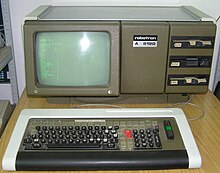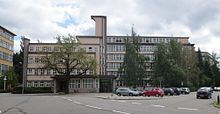Astraworks
| Astrawerke AG VEB Booking Machine Factory Karl-Marx-Stadt Robotron Ascota AG |
|
|---|---|
| legal form | |
| founding | 1921 |
| resolution | 1993 |
| Reason for dissolution | Liquidation and sale to IBM |
| Seat | Chemnitz , Germany |
| Number of employees | 10,386 (early 1970s ) |
| Branch | Office machine manufacturer |
The Astra Werke AG in Chemnitz (later VEB booking engines work Karl-Marx-Stadt and Robotron Ascota AG ) was an important German office machine manufacturer. The company mainly produced calculating and accounting machines , later also office computers and systems for electronic data processing .

history


In 1919, John Greve (1880-1967), who previously for ten years chief designer at the Walker works had been its own mechanical workshop in Chemnitz city and began the development of a new calculator, the later Astra Model A . In 1921 he founded with financial support of the banker Wilhelm Nicolaus Dannhof the Astra Werke AG and started production. Since the late 1920s, Astrawerke has been the market leader for booking machines in Europe, the workforce increased from 175 in 1923 to over 2,600 in 1944. During World War II , Astrawerke also increasingly produced armaments and were partially destroyed in air raids.
After the end of the war, the Astrawerke were initially placed under trust administration and nationalized as a state-owned company (VEB) in 1948 . Company founder Greve went to the West and tried a new start with Exacta Büromaschinen GmbH, later also with the formal relocation of Astrawerke to Cologne. In 1953, the Chemnitz company was temporarily merged with the office machine department of the Wanderer-Werke to form the VEB Büromaschinenwerk Chemnitz , but separated again a year later and continued as the VEB Booking Machine Works Karl-Marx-Stadt . In 1955, the production of the class 170 booking machine began, which was manufactured over 300,000 times by 1983 and exported to over 100 countries. After Greve had fought for the right to the brand name Astra in years of legal dispute, the Chemnitz products were marketed under the new brand name Ascota (from Astra and Continental, the former Wanderer typewriter brand) from 1959 .
At the beginning of the 1970s, the workforce reached its peak of 10,386 employees. Since 1969 the company belonged to the Zentronik combine and after its dissolution from 1978 to the Robotron combine . As a result, production gradually shifted to office computers such as the A5120 or EC 1834 , computer components and accessories such as B. Floppy drives changed.
After the reunification in the GDR , the booking machine factory was renamed Robotron Ascota AG in 1990 and liquidated between 1991 and 1993. A small part of the company with around 200 employees was taken over by the IBM group in 1993 .
Building and current use


The company building on Altchemnitzer Strasse was built in 1928/29 by the Chemnitz architect Willy Schönefeld in the style of the Bauhaus- influenced New Objectivity and expanded in 1937/38. The complex consists of a horseshoe-shaped five- to six-story production wing as well as a four-story administration wing with a horizontally structured plastered facade and a prominent tower. While part of the rear building was demolished in the 1990s in order to create open spaces and parking spaces, the listed administrative building was extensively restored and now serves as the headquarters of the State Office of Saxony .
literature
- Friedrich Naumann: Chemnitz is to be expected. Saxon Industrial Museum, Chemnitz 2012, ISBN 978-3-934512-24-5 .
Web links
- Chronology of Astrawerke AG on altes-chemnitz.de
- VEB Booking Machine Plant Karl-Marx-Stadt on robotrontechnik.de
Individual evidence
- ↑ a b c Astra works. In: altes-chemnitz.de. July 1, 2003, accessed September 9, 2017 .
- ↑ a b VEB Booking Machine Plant Karl-Marx-Stadt. In: www.robotrontechnik.de. Retrieved September 9, 2017 .
- ^ Arnold Betzwieser: Small exhibition "Historical office technology". Retrieved September 9, 2017 .
- ↑ Bernd Kuska: History | Chemnitz office. Retrieved September 9, 2017 .
Coordinates: 50 ° 48 ′ 58.1 ″ N , 12 ° 54 ′ 59.7 ″ E